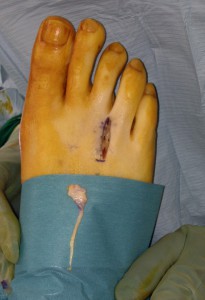With the London Marathon coming up, friends, Patients and colleagues often ask me about what spectrum of injuries I see.
We all know of the more common ones affecting the Foot and Ankle including Achilles Tendinitis, Shin Splints and stress fractures. But have you heard of something called a Morton’s Neuroma?
It shocks me how common they really are- indeed I think its one of the commonest causes of forefoot pain in runners. I probably see and treat very large numbers partly because of the demographics of my referral base, which often comprises younger athletic patients and runners. Running is a boom sport in London!
A Morton’s Neuroma is the name used to describe the enlargement of one of the nerves travelling to your toes in your forefoot. It is more likely to affect women than men.
Morton’s neuromas develop between your third and fourth metatarsal bones and your toes or between the second and third metatarsal. Neuromas are benign, or non-cancerous, and often respond to conservative care methods.
The clinical diagnosis is usually the most effective way to diagnose neuromas. In the clinic, I try to duplicate neuroma symptoms by pressing on the involved nerve at various points and try to cause a clicking of your nerve that indicates nerve enlargement. It can be a painful manoeuvre but it often clinches the diagnosis.
X-rays of your affected foot will not show a neuroma, as neuromas are made up of soft tissue. An Ultrasound is the best diagnostic test.
A narrow toe-box especially with a heel can contribute to the problem; hence it’s more of an issue in women (or maybe men on Saturdays!)
Other factors that may contribute to Morton’s neuromas include:
- Flat feet
- Bunions, hammertoes, and other forefoot problems as they throw the weight onto the lesser metatarsals
- Excessively high foot arches
Some of the most common signs and symptoms of a Morton’s neuroma include:
- Burning, stinging, stabbing, or shooting pain in the ball of your affected foot
- A tingling sensation between your third and fourth toes
- Foot cramping
- Foot numbness
- The sensation that you are walking on a lump
Conservative treatment involves using footwear that allows your forefoot to spread. High heels cause neuromas by squeezing and stretching your involved intermetatarsal nerve across the ball of your foot and should be avoided as often as possible.
Test shoes before you buy them to see if they are appropriate for your feet. Select shoes that have a removable liner or insole and stand on the liner, noting the position of your foot. If your foot is wider than your liner, that shoe will irritate your neuroma by squeezing your metatarsal bones together.
You may need a metatarsal dome if wider shoes alone fail to relieve your interdigital neuroma symptoms. A metatarsal pad will help spread your metatarsal bones and reduce pressure on your affected nerve as it travels under the ball of your foot. The is important.
Other conservative care remedies include ice therapy and anti-inflammatory medications or supplements. If conservative care measures fail to resolve your problem, I may recommend a cortisone injection around your involved nerve to help reduce your swelling and inflammation. Neurectomy, a surgical procedure to remove the enlarged, traumatized portion of your involved nerve produces consistent results when other measures fail. The mild numbness after surgery rarely causes the patients problem.

